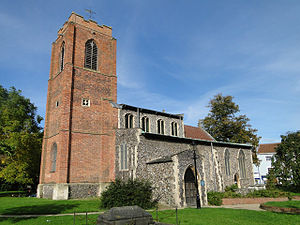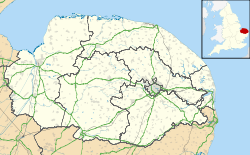- St Augustine's Church, Norwich
-
St Augustine's Church, Norwich 
St Augustine's Church, Norwich, from the southwestLocation in Norfolk Coordinates: 52°38′14″N 1°17′33″E / 52.6372°N 1.2925°E OS grid reference TG 228 095 Location St Augustine's Street,
Norwich, Norfo lkCountry England Denomination Anglican Website Churches Conservation Trust Architecture Functional status Redundant Heritage designation Grade I Designated 26 February 1954 Architect(s) R. M. Phipson (restoration) Architectural type Church Style Gothic Closed 1997 Specifications Materials Flint with stone and brick dressings
Brick towerSt Augustine's Church, Norwich, is a redundant Anglican church in the city of Norwich, Norfolk, England. It has been designated by English Heritage as a Grade I listed building,[1] and is under the care of the Churches Conservation Trust.[2] The church stands to the west of St Augustine's Street, the A1024 road, to the north of the Norwich inner ring road.[2][3]
Contents
History
St Augustine's is the only pre-Reformation church in Norfolk with this dedication.[4] The earliest documentary evidence of a church dedicated to St Augustine in Norwich dates from 1163 in a letter from the bishop of Norwich, William de Turbe, to the prior of Llanthony Secunda Priory in Gloucester.[5] Nothing of this Norman church survives. The church was substantially rebuilt in the early 15th century. The tower was added in 1682–87 after the flint tower collapsed. The date 1687 was added, presumably on completion, to the east-facing parapet. In the 1880s R. M. Phipson restored part of the fabric of the church and reordered the interior. During the 20th century the condition of the building deteriorated. By the 1990s the tower had become dangerous and the church's three 17th-century bells (which pre-date the new tower) were removed and donated to All Saints church, Carleton Rode.[6] The church was declared redundant in 1997, and was vested in the Churches Conservation Trust in 2000.
Architecture
Exterior
The body of the church is constructed in flint with stone and brick dressings. The tower is in brick on a flint plinth, and is the only one of its kind in the city.[2] The church is square in plan, with the nave and chancel being similar in length, and the aisles running along their full length. There is also a clerestory extending along the length of the nave, a south porch, and a rood turret against the wall of the north aisle. The tower is at the west end, and is in three stages. In the lowest stage is a west window with a pointed arch. The middle stage contains small square windows on each side, and in the top stage the bell openings have two lights. The parapet is rendered and battlemented. The nave is in four bays and contains two-light windows with Decorated tracery. The clerestory has four two-light windows on each side containing Y-tracery. The chancel is in two bays, with three-light Perpendicular windows in the aisles, and a five-light east window.[1]
Interior
The arcades are carried on octagonal piers.[1] The font dates from the 15th century. The pews and the reredos are from the 1880s, and the screen, which incorporates the pulpit and a reading desk, was added in 1920 as a memorial to those who died in the First World War. The memorials include a marble wall monument to the Palladian architect Matthew Brettingham, who designed Holkham Hall, and other family members,[2][7][8] and one to a textile manufacturer, Thomas Clabburn, erected by "upwards of six hundred of the weavers of Norwich and assistants".[2][7][9][10] There is little stained glass; that in the east window dates from 1870, and the glass in the north chancel aisle, depicting SS Felix of Dunwich and Augustine of Canterbury, dates from 1901. A window by Morris & Co. in the south nave aisle, depicting the Mary Magdalene, Mary the Mother of James and the angel at the empty tomb, dates from 1920 and is a memorial to a soldier of the parish who was killed in action in 1917. The two-manual organ was transferred from St Peter's Church, Hungate, (which is now a museum). It was built in 1875–78 by John Rayson, and restored in 1959–60 by Hill, Norman & Beard.[11][12]
See also
- List of churches preserved by the Churches Conservation Trust in the East of England
References
- ^ a b c "St Augustine's Church, Norwich", The National Heritage List for England (English Heritage), 2011, http://list.english-heritage.org.uk/resultsingle.aspx?uid=1051896, retrieved 20 May 2011
- ^ a b c d e St Augustine's Church, Norwich, Norfolk, Churches Conservation Trust, http://www.visitchurches.org.uk/Ourchurches/Completelistofchurches/St-Augustines-Church-Norwich-Norfolk/, retrieved 25 March 2011
- ^ Norwich, Streetmap, http://www.streetmap.co.uk/map.srf?x=622850&y=309550&z=0&sv=TG228095&st=5&mapp=map.srf&searchp=ids.srf, retrieved 23 February 2011
- ^ Linnell, C.L.S. (1962). Norfolk Church Dedications. York: St. Anthony's Press. pp. 17.
- ^ Harper-Bill, Christopher (1990). English Episcopal Acta VI: Norwich 1071-1214. Oxford: OUP.
- ^ Meeting as a church at St Augustine's, Norwich Christian Meditation Centre, http://www.norwichmeditation.co.uk/Groups/69819/Norwich_Meditation/St_Augustines/St_Augustines.aspx, retrieved 24 February 2011
- ^ a b Monuments in St Augustine, Norwich Historic Churches Trust, http://www.norwich-churches.org/St%20Augustine/monuments.html, retrieved 24 February 2011
- ^ Matthew Brettingham, Norwich Historic Churches Trust, http://www.norwich-churches.org/St%20Augustine/images/Matthew_Brettingham_monumen.jpg, retrieved 24 February 2011
- ^ Thomas Clabburn, Norwich Historic Churches Trust, http://www.norwich-churches.org/St%20Augustine/images/Thomas_Clanburn_monument.jpg, retrieved 24 February 2011
- ^ See The Descendants of Thomas Clabburn, born 1760 at airgale.com.au. The memorial reads: "This tablet is erected to the memory of Thomas Clabburn, manufacturer, by upwards of six hundred of the weavers of Norwich and assistants in his establishment as a mark of esteem for his many virtues as an employer and a kind good man. He departed this life March 31st 1858 aged 70." Clabburn was a Silk Weaver, Manufacturer & Merchant in Magdalen Street, Norwich.
- ^ Norfolk, Norwich, St. Peter (now a museum), Hungate, (N06515), British Institute of Organ Studies, http://www.npor.org.uk/cgi-bin/Rsearch.cgi?Fn=Rsearch&rec_index=N06515, retrieved 24 February 2011
- ^ Norfolk, Norwich, St. Augustine (N06497), British Institute of Organ Studies, http://www.npor.org.uk/cgi-bin/Rsearch.cgi?Fn=Rsearch&rec_index=N06497, retrieved 24 February 2011
External links
Categories:- Grade I listed buildings in Norfolk
- Grade I listed churches
- Church of England churches in Norwich
- English Gothic architecture
- Churches preserved by the Churches Conservation Trust
Wikimedia Foundation. 2010.

